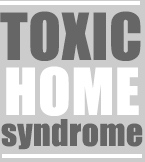What is Toxic Home Syndrome?
This is a recently created term for those dwellings which suffer from unsatisafactory build ups of indoor air pollutants generally caused by a lack of ventilation which lead to an impact on the health of a building and its occupants.
What are indoor air pollutants?
There are a wide range of pollutants in the air and their impact on health can vary considerably. They include:
Biological Pollutants
Mould spores (microscopic particles) are found everywhere. They are released into the atmosphere by damp spots on walls, window frames or even decaying food. They can be common in houses which have little or no ventilation. Pollen can be a pollutant factor in your home, usually brought in from outside either by leaving your windows open in high pollen seasons or even by walking around the house in shoes you have worn outside. Dander is tiny particles, which come from feathers, skin, or hair, that may cause allergies.
VOCs
A lot of everyday cleaning products contain chemicals known as volatile organic compounds (VOCs). VOCs can trigger asthma and are found in air fresheners, carpet cleaners, polish and oven cleaners.
Gases
Radon is a natural radioactive gas that comes mainly from the soil. It can enter a home through:
- cracks in solid floors
- construction joints
- cracks in walls
- gaps in suspended floors
- gaps around service pipes
- cavities inside walls
- the water supply
Carbon Monoxide is a gas that has no odour or colour and can have a serious effect on your health. It is present in homes through:
- cooking
- heating
- from the outdoor environment
- clogged chimneys
- wood burning
- incense burning
- cigarette smoke
- burning candles
Building Materials
Paint can contain lead and formaldehyde which can lead to health problems such as breathing difficulties, increased blood pressure and joint pain. Asbestos is the name of a group of minerals with long, thin fibres that are so small you can’t see them. If you disturb asbestos, the fibres can float in the air. This makes them easy to inhale, and some may become lodged in the lungs.
What are the personal signs or symptoms?
- Headaches and dizziness
- Nausea (feeling sick)
- Aches and pains
- Fatigue (extreme tiredness)
- Poor concentration
- Shortness of breath or chest tightness
- Eye and throat irritation
- Irritated, blocked or runny nose
- Skin irritation (skin rashes, dry itchy skin)
What are the signs or symptoms in a building?
- Mould growth
- Excess condensation
- Condesation not disappearing quickly
- Damp
- Dust build up in ventilation equipment
Is Toxic Home Syndrome the same as Sick Building Syndrome?
Sick Building Syndrome was a phrase coined in the 1980s and 1990s which related to commercial buildings, where studies had shown that improved building methods combined with the proliferation of air conditioning systems (which to be effective generally meant windows should not open) had lead to an impact on the health of office workers, for instance.
In a heavily occupied building, disease and illness can spread quickly and remain active for a considerable time, having an effect on individual and overall productivity.
< back home



